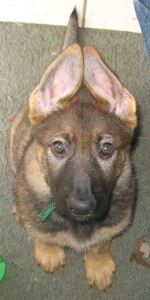Dealing With Puppy Biting, Barking, and Chewing
Now that your home is puppy-proofed and ready for your puppy, let’s talk about puppy behavior. Puppies may be cute, cuddly, and furry, but they also engage in natural behaviors that many pet owners find annoying, such as biting, barking, and chewing. To help your pup become a well-trained German Shepherd Dog, you can modify any unwanted behavior by following a few simple principles: manage the situation/environment, redirect and refocus the behavior, and reward the correct behavior.
Biting
It is natural for puppies to nip and mouth their siblings and other members of their pack. But those little needle-sharp teeth hurt sensitive human skin, causing a significant amount of discomfort. Manage the environment by identifying “triggers” that get the dog worked up to the point he bites or mouths, and then use management tools (like a collar and lead) to help restrict the unwanted behavior (such as jumping up to nip at the hands–stepping on the lead prevents the jumping up, which then helps curtail the biting at the hands.). Then, redirect and refocus the behavior, directing the puppy’s attention to a toy (or to food/treats). Encourage him to bite and play tug with the toy rather than your arm or hand, and then reward him with calm praise while he grabs the toy. When the pup does make contact with skin, teach him bite inhibition to help him learn to control his bite. One of the easiest ways to do this is to “yelp” like another puppy or dog would, and cease playing. Alternatively, redirect the pup’s attention to a toy, and reinforce the behavior of grabbing a toy instead of your hands. Whenever the pup gets nippy, redirect immediately to a toy.
Barking
All dogs bark in some degree or another. While we do not recommend completely discouraging barking–particularly for a trained German Shepherd watchdog or protection dog–you do not want to allow your puppy to get into the habit of nuisance barking or firing off at other dogs. In each case, identify the behavior you want to see, then follow the principles above. Manage the environment: if your puppy is barking at other dogs, remove him from the situation or move him farther away where he is not triggered by the stimulus of the other dog. Redirect the behavior by distracting him with a toy or by encouraging him to refocus on you, and reward him with treats or play for being quiet. Later on, you can teach him to “bark” on command and then to stop barking on command.
Chewing
Puppies have a biological need to chew, particularly when they enter the teething stage at about 4 months of age. Chew toy training is very important, as it teaches your puppy what to chew and what not to chew. After puppy-proofing your house and removing items from the puppy’s reach, provide appropriate chew toys (NOT squeaky toys or stuffed animals–these are not actual chew toys) for your puppy to chew on under your supervision (to ensure that he continues to use the chew toy, not the table leg). Appropriate chew toys are heavy duty rubber items like Kongs, which can also be stuffed with treats to make it more entertaining for the puppy. Raw beef marrow or knuckle bones also make excellent chews for puppies as they teethe. Use the same principles listed above: manage the environment (by removing items that should not be chewed), redirect and refocus the pup if he chooses to chew something inappropriate, and reward the correct behavior with praise, petting, and treats.
With consistent redirection toward and repetition of the desired behaviors, you will soon have a puppy that is well on his way to being a well-trained dog.
Happy training,
CK


